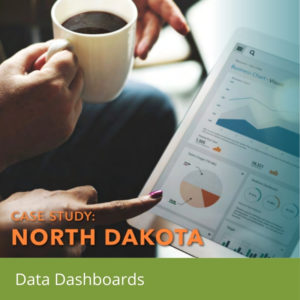
Career Technical Education (CTE) stakeholders — including families, employers and local practitioners at the secondary and postsecondary levels — need access to relevant and timely data to make informed decisions when it matters. For all the data CTE leaders collect, processing, cleaning and sharing relevant information can take a year or more, making it far less useful for practitioners on the ground. State leaders should ensure that information is relevant, timely and disaggregated so that stakeholders can understand and act on the data. This requires states to provide a comprehensive view of their career readiness system; differentiate reports by user; make data available when it matters; and disaggregate data by population, program and institution.
To improve the relevance and timeliness of CTE data, North Dakota created a statewide longitudinal data system (SLDS) that feeds data into public and internal data dashboards on a daily basis through PowerSchool, a data management system that all public school districts use to collect data on attendance, grades and other metrics. North Dakota’s postsecondary institutions also upload their data to the state’s SLDS, allowing for linkages between the K-12 and postsecondary sectors. These data dashboards provide stakeholders with timely information that they can use to make important education, career and policy decisions.
The SLDS currently includes data on K-12 student demographics, attendance and enrollment, assessment performance, CTE participation, graduation and dropout rates, historical grades, and college and career readiness. The SLDS also includes postsecondary data on student enrollment, courses, performance, demographics and graduation rates. Workforce data such as wage and employment information are fed into the SLDS by Job Service North Dakota, the state’s workforce development agency. North Dakota’s SLDS also collects data on CTE participation, concentration and completion rates along with credential attainment. Soon, the SLDS will include data on work-based learning completion.
Through a public dashboard tool called Insights, policymakers, agencies, researchers and the general public can access data on preparation and outcomes for education and workforce training programs and use that data to make informed decisions. The reports generated on Insights are user friendly and easily accessible to the general public. Examples of reports and data that users can explore on Insights include the demand for a particular occupation, the average salary of that occupation, the CTE program of study that could lead to a career in that occupation, and which institutions offer that program.
The SLDS also provides data to the North Dakota Education Portal, a set of dashboards available to public school teachers and administrators that provide information on metrics such as predicted learner outcomes, high school and college readiness and historical learner data. The North Dakota Department of Education and its public postsecondary institutions have access to internal data on the North Dakota Education Portal, with levels of access differentiated by user. Additionally, the portal provides learners and families direct services such as access to transcripts and the ability to send transcripts to any postsecondary institution in the state or participating in the National Student Clearinghouse, thereby making applying to those institutions easier. High school students are also able to apply to North Dakota postsecondary institutions for dual credit enrollment and complete some first-year applications online through the student portal.
North Dakota’s SLDS and data dashboards equip stakeholders, including local CTE practitioners, to make data-informed decisions when it matters by providing data in a way that is timely, relevant and actionable.
Read the Advance CTE Case Study North Dakota: Data Dashboards to learn more about how North Dakota’s data dashboards have helped to foster a data- and information-rich culture throughout the state. For additional resources on improving the quality and use of career readiness data, check out the Career Readiness Data Quality microsite.
This is the fifth edition in a series of Advance CTE data quality blogs to accompany Advance CTE’s latest releases, Career Readiness Data Quality and Use Policy Benchmark Tool and Data Quality Case Studies. For more resources on data and accountability in CTE, please visit the Learning that Works Resource Center.
Brian Robinson, Policy Associate
